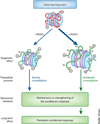Epigenetics and persistent memory: implications for reconsolidation and silent extinction beyond the zero
- PMID: 23354385
- PMCID: PMC3740093
- DOI: 10.1038/nn.3302
Epigenetics and persistent memory: implications for reconsolidation and silent extinction beyond the zero
Abstract
Targeting epigenetic mechanisms during initial learning or memory retrieval can lead to persistent memory. Retrieval induces plasticity that may result in reconsolidation of the original memory, in which critical molecular events are needed to stabilize the memory, or extinction, in which new learning during the retrieval trial creates an additional memory that reflects the changed environmental contingencies. A canonical feature of extinction is that the original response is temporarily suppressed, but returns under various conditions. These characteristics have defined whether a given manipulation alters extinction (when persistence does not occur) or reconsolidation (when persistence does occur). A problem arises with these behavioral definitions when considering the potential for persistent memory of extinction. Recent studies have found that epigenetic modulation of memory processes leads to surprisingly robust and persistent extinction. We discuss evidence from behavioral epigenetic approaches that forces a re-evaluation of widely used behavioral definitions of extinction and reconsolidation.
Figures


References
Publication types
MeSH terms
Grants and funding
LinkOut - more resources
Full Text Sources
Other Literature Sources

